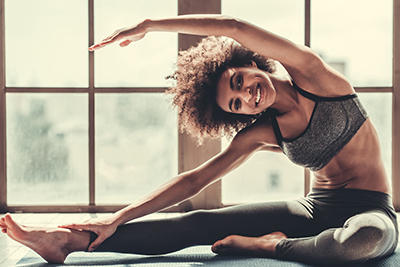 Stretches—they may not be the key to your most intense workouts, but they can be key to your recovery. Plus, releasing tight muscles helps you offset everyday habits and be fit.
Stretches—they may not be the key to your most intense workouts, but they can be key to your recovery. Plus, releasing tight muscles helps you offset everyday habits and be fit.
-
There are a variety of ways to stretch, some more appropriate than others for certain purposes:
- Dynamic stretching includes activities that warm up and lengthen muscles and joints before a workout or athletic performance. An example of that might be lunging side-to-side and reaching over head to dynamically stretch calves, hips and sides, or arm circles to stretch the shoulders and chest.
- Static stretching, which is basically a “stretch and hold” approach to flexibility work, is useful after and between workouts, to help increase range of motion overall, improve recovery and even reduce post-work out soreness. Forward fold pose in yoga is an example of a static stretch for the hamstrings.
- Dynamic static stretching helps you achieve a nice balance between these two common approaches to stretching. You will stretch and hold within your comfort zone for several seconds, then actively contract your muscles before relaxing for a few more seconds. You can repeat this sequence to go a little deeper into the stretch the second time.
In this two-part series, we’ll cover a selection of stretches you can use on a regular basis. Let’s start at the top of the body with stretches for your chest and back muscles. In our next edition, we’ll cover smart stretches all the way down to down to the feet.
Chest Stretch: Pectoralis Major
These are your larger chest muscles fondly known as “pecs” – they stretch across each side of your upper rib cage to the front of your shoulder/upper arms.
Function: The pecs can be extra tight from the forward-reaching activities you might spend hours on each day, like driving or computer work. Tight pecs affect your posture and your shoulder function, too.
Stretch:
- Stand facing a corner, with your feet staggered–one in front, one behind.
- Bend your elbows and hold arms up (like the touchdown sign).
- Place hands and forearms, one on each wall, bend front knee.
- Lean your torso and chest forward, till a slight stretch is felt.
- Hold for 10 seconds.
- Press into the wall harder as if you were trying to move it.
- Hold that contraction for 10 seconds.
- Relax for 5 seconds. Repeat.
- Change sides by switching which foot is forward, and repeat all the above.
Back Stretch: Latissimus Dorsi
These are your larger muscles that cover the sides of your back under the shoulder blades down to your waistline. You might know them as your “lats.”
Function: When you don’t move your arms over your head very often, your lats are stuck in a shortened position. Tight lats can ultimately cause pain in your shoulders or even in your lower back.
Stretch:
- Kneel facing a stability ball in front of you on the floor.
- Place your right hand and wrist, palm down, on the top of the ball.
- Pull your hips back, look down and roll the ball away from you and to the left.
- Stretch your right arm to across your body till a slight stretch is felt.
- Hold for 10 seconds.
- Press down with your hand into the ball, as if you were trying to pop it.
- Hold that contraction for 10 seconds.
- Relax for 5 seconds. Repeat.
- Change sides by switching which hand is on the ball, and repeat the above.


